South Dakota‘s unique climate, classified under USDA plant hardiness zones 3-5, offers gardeners both challenges and opportunities. The summer’s warmth is perfect for a variety of perennial flowers that thrive and also add vibrant beauty to local landscapes. Choosing the right flowers that can handle the heat (and cold) is essential for any South Dakota garden. Dive into our list of the best perennial flowers that are not only stunning but also heat-loving, ensuring your South Dakota garden remains a picturesque oasis even during the warmest months!
South Dakota USDA Plant Hardiness Zones
First, before we dive in, let’s discuss the state’s USDA hardiness zones in order to determine which flowers would thrive. These zones categorize the region based on its average annual minimum winter temperatures, helping individuals select plants that can thrive in their specific location.
As mentioned above, in South Dakota, these zones range from the frigid Zone 3a in the northeastern corner, with winter lows plummeting to -40°F, to the more temperate Zone 5b in the southernmost tip, where minimum temperatures hover around -10°F. Understanding these zones is absolutely crucial for creating the most resilient and beautiful gardens and landscapes that can withstand the state’s diverse climate.
1. Common Yarrow (Achillea millefolium)
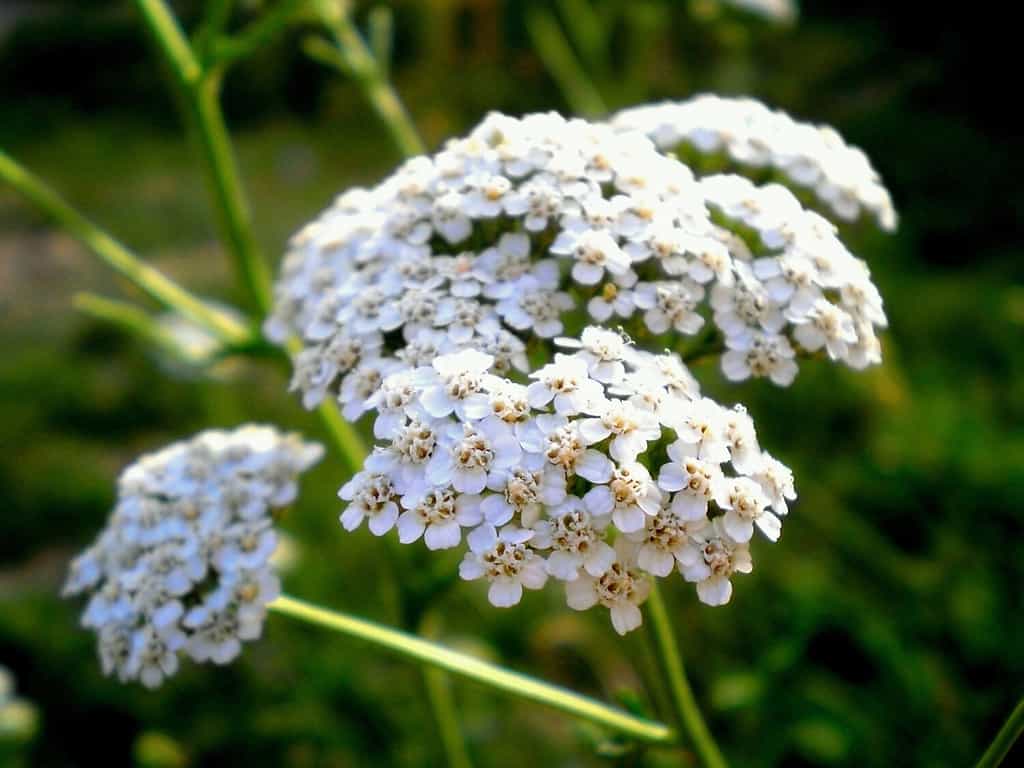
The beautiful white perennial flowers of the common yarrow are a great addition to South Dakota gardens.
©SakSa/Shutterstock.com
Common yarrow is a top perennial choice for South Dakota gardens. This graceful wildflower boasts large, 5-inch clusters filled with around 20 to 25 delicate creamy-white blooms. Rising high on sturdy stems, these clusters are set against a backdrop of aromatic, fern-like green leaves.
The common yarrow’s charming blooms and leaves remain fresh for a long time. This makes it an excellent addition to gardens and ideal for natural prairie or meadow settings. If you’re looking to attract bees and butterflies, this plant is a must-have!
For optimal growth, plant the yarrow in a spot that gets plenty of sunlight. It flourishes in medium moisture, well-draining soils and can tolerate a bit of shade. But with that said, full sunlight ensures the brightest colors and most abundant blooms.
Start seeds indoors about 8 to 10 weeks before the final frost, and then transfer them outside either in the early spring or the beginning of summer.
2. Russian Hollyhock (Alcea rugosa)
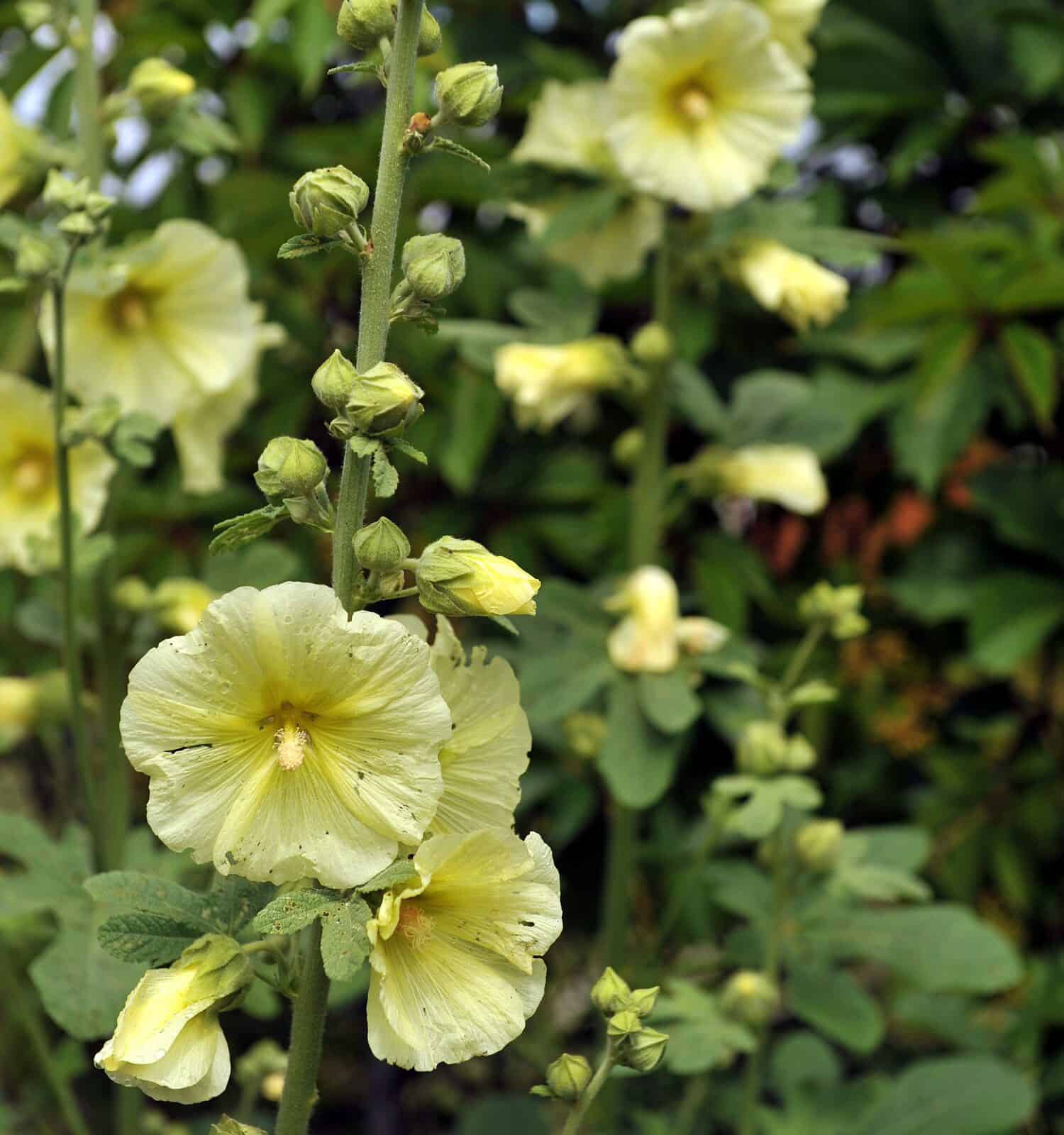
A favorite of hummingbirds and butterflies, Russian hollyhock can add some beautiful vertical dimension to any South Dakota garden.
©Sergey V Kalyakin/Shutterstock.com
Russian hollyhock adds a vertical dimension to garden spaces, standing tall as a short-lived perennial. It showcases tall spikes dotted with pale yellow, funnel-like blooms that feature a distinctive column in their centers.
From late spring until the end of summer, the eye-catching blossoms form in a circular pattern on the spike, unfurling from the bottom upwards. The plant also sports large, deeply cut, slightly crinkly leaves. Traditionally loved in gardens, hollyhock looks striking when positioned against walls, fences, or at the back end of a flower bed.
The best part? Hummingbirds, drawn to the flowers’ nectar, hover close to them, and butterflies are also frequent visitors.
For the best results, place hollyhock in a sunny spot with moderate moisture and ensure the soil drains well. Planting its seeds directly into the garden during May and June is recommended.
3. Lady’s Mantle (Alchemilla mollis)
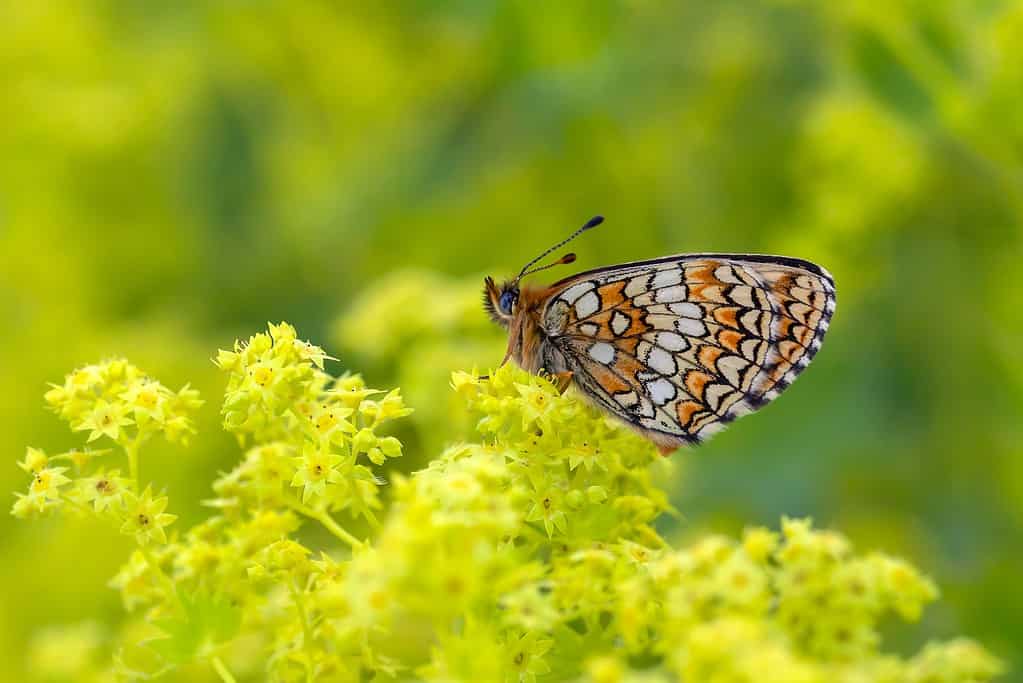
Lady’s mantle is an award-winning and popular perennial flower for South Dakota gardens.
©Kenan TALAS/Shutterstock.com
Dating back to the 1800s, the award-winning lady’s mantle is a perfect touch to borders and pathway edges, seamlessly complementing other perennials. This perennial grows in compact bunches, flaunting scalloped, toothy, and slightly fuzzy light green leaves. These leaves have a unique ability to hold onto dewdrops or raindrops, giving them a sparkling appearance post-rain.
By late spring and early summer, tiny star-like greenish-yellow blossoms spring up just above the leaves. Having received awards like the Award of Garden Merit from the Royal Horticultural Society in 1993, lady’s mantle is a popular choice deserving of space in many South Dakota gardens.
While deer and rabbits tend to avoid it, butterflies are drawn to this plant.
Lady’s mantle thrives in spots that get either full sunlight or partial shade and prefers moderately moist, well-draining ground. Ideally suited for USDA zones 3 to 8, this plant fits right in with South Dakota’s climate. Plant it outside as spring begins, once the frosty nights are behind.
4. Blue Star (Amsonia tabernaemontana)
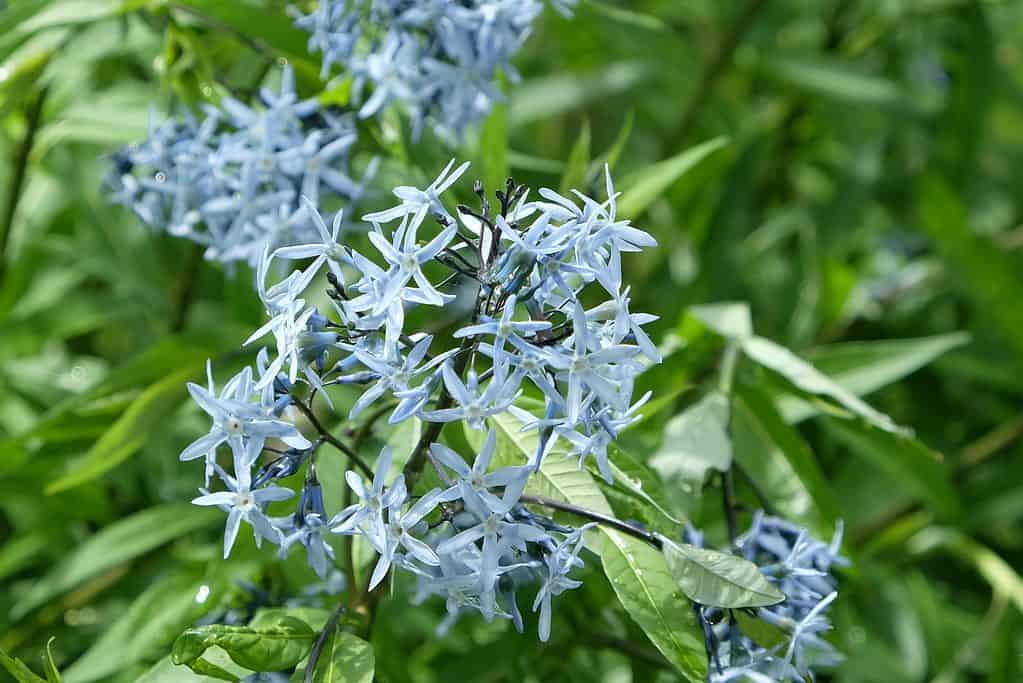
Blue star, as its name suggests, boasts blue star-shaped flowers.
©Alex Manders/Shutterstock.com
Recognized by the American Horticultural Society as a top pick among 75 stellar plants for U.S. gardens, the blue star is a perennial prized for its springtime azure flowers, eye-catching summer leaves, robust growth, and golden hues in the fall months.
During late spring to early summer, blue star displays groups of gentle blue, starry flowers on upright, leaf-rich stems. These blooms are a favorite for long-tongued critters, including carpenter bees, butterflies, and hummingbird moths. Additionally, the nectar is a treat for ruby-throated hummingbirds.
Growing blue star is hassle-free. It thrives in typical soil with decent moisture and good drainage, preferring a mix of full sun and light shade. For those wanting to grow from seeds, plant them in the fall months, let them winter in a shielded spot or cold frame, and then move outside in spring.
5. Snowdrop Anemone (Anemonoides sylvestris)

Blooming from late spring to early summer, the snowdrop anemone is a great perennial flower to add to any South Dakota garden.
©Mariola Anna S/Shutterstock.com
Snowdrop anemone emerges as a stunning flower in the late spring to early summer, making it a perfect ground cover for spots that enjoy a bit of shade. Its aromatic, white blossoms, about 2 inches wide, showcase a distinctive circle of bright gold stamens. These flowers stand out on slender stems, contrasting with the deeply cut dark green leaves beneath. Plus, they’re great for bouquets!
Following the bloom, the petals transition into fluffy, white seed heads that add another layer of visual treat.
Growing snowdrop anemones is quite easy. It prefers moderately moist, well-draining soil and thrives best in partial to full shade. Plant it in spring, ensuring there’s no more risk of frost.
6. Rocky Mountain Columbine (Aquilegia caerulea)
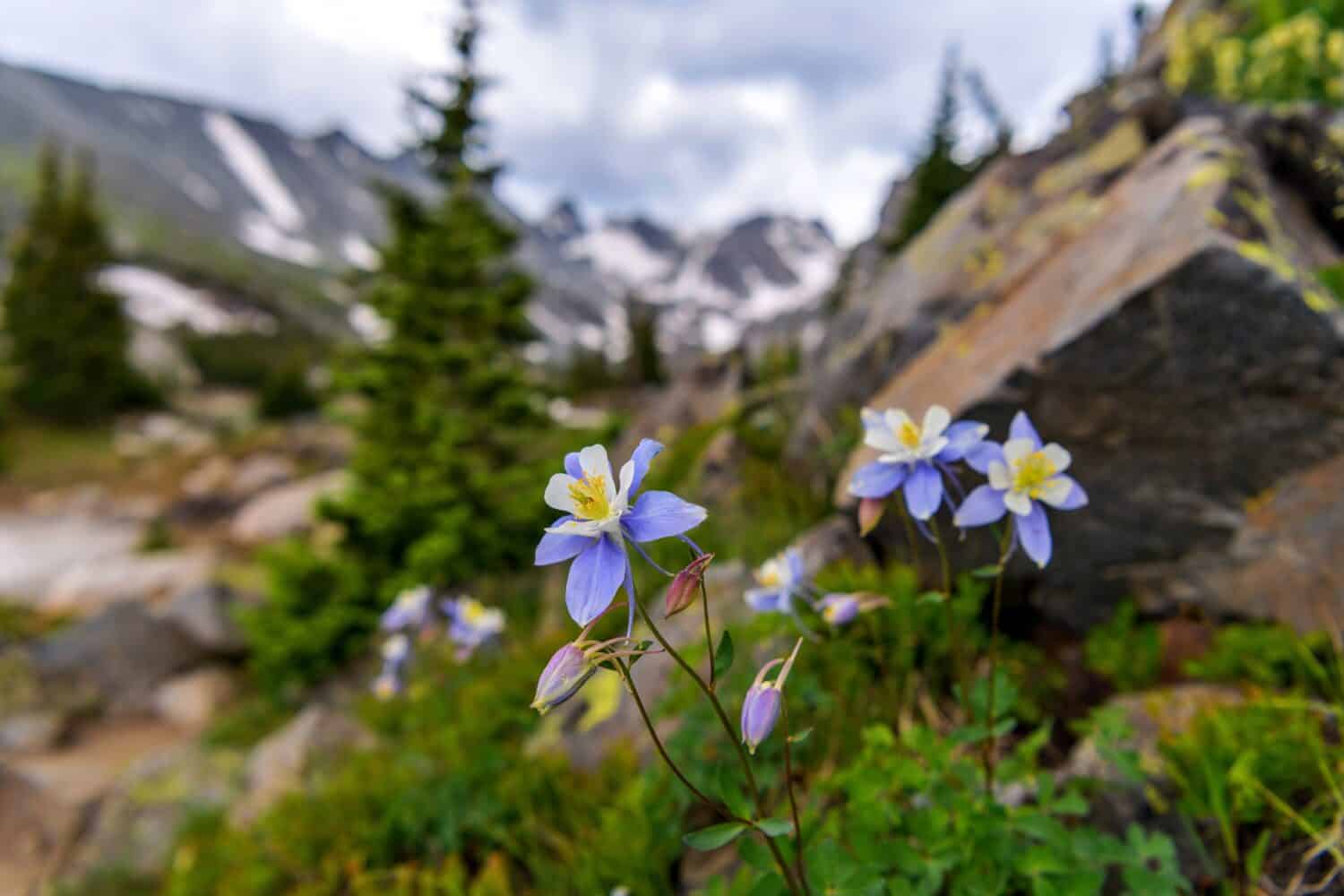
The Rocky Mountain columbine boasts blooms that are 2 to 3 inches wide.
©Sean Xu/Shutterstock.com
Originating in areas spanning from Montana to Arizona and New Mexico, the Rocky Mountain columbine has sizable, long-spurred blooms that blend creamy white and violet-blue colors. These 2 to 3-inch wide flowers also feature bright yellow centers, offering a stark contrast.
Their unique design has them facing upwards, beautifully showcasing themselves atop delicate, fern-like, gray-green leaves. This perennial graces gardens from late spring to early summer, blooming for nearly a month or more. Recognized as Colorado‘s official state flower, it’s a splendid choice for shaded garden spots.
Having earned the notable Award of Garden Merit from the Royal Horticultural Society, its beauty is undeniable. It’s a magnet for hummingbirds and butterflies but, thankfully, remains off the menu for deer and rabbits.
For optimal growth, the Rocky Mountain columbine thrives in both sunny and partially shaded locations with moderately moist, well-draining soil. Those interested in growing it can plant its seeds directly outdoors in spring once frost threats have subsided.
7. Sea Thrift (Armeria maritima)

An evergreen perennial, sea thrift has blossoms that stand on thin stems and bloom in mid to late spring.
©Oakland Images/Shutterstock.com
Sea thrift is a small, evergreen perennial showcasing round bunches of flowers ranging from pink to lavender, and occasionally white. These blossoms stand tall on thin stems, primarily flourishing from mid to late spring, though you might spot a few more blooms throughout the summer.
This plant grows into a tight, rounded cluster of grassy, deep green leaves that gradually expand. Its effortless maintenance and delightful appearance make it ideal for lining pathways or defining garden edges. Plus, those looking to add a fresh touch to their homes can snip a few flowers for a vase.
For the best results, plant sea thrift in sunny spots with dry and well-draining soil. If you’re starting from scratch, sowing its seeds in the spring or fall is recommended. Typically, you can expect to see its lovely flowers by the second year.
8. Heartleaf Bergenia (Bergenia cordifolia)

Boasting gorgeous flowers, heartleaf bergenia is beautiful all year.
©shalom3/Shutterstock.com
Native to Siberia, heartleaf bergenia is a robust and extremely cold-tolerant evergreen perennial. During early spring, this plant displays clusters of deep-pink flowers, which sit atop glossy, heart-shaped leaves, all held up by sturdy red stems.
While these broad leaves maintain a deep green color during summer, they take on a purplish-bronze shade in colder months, ensuring the plant remains captivating all year. These leaves, stretching up to 12 inches in length, are also a popular choice for floral designs.
Heartleaf bergenia thrives in nutrient-rich, moist soils and can handle both sunlit and partially shaded spots. Remarkably, it’s also adaptive to areas with dense shade. Spring or fall is the prime time for planting or splitting up this perennial, and with a little patience, it reaches its full growth potential in a span of two to five years.
9. Cusick’s Camas (Camassia cusickii)
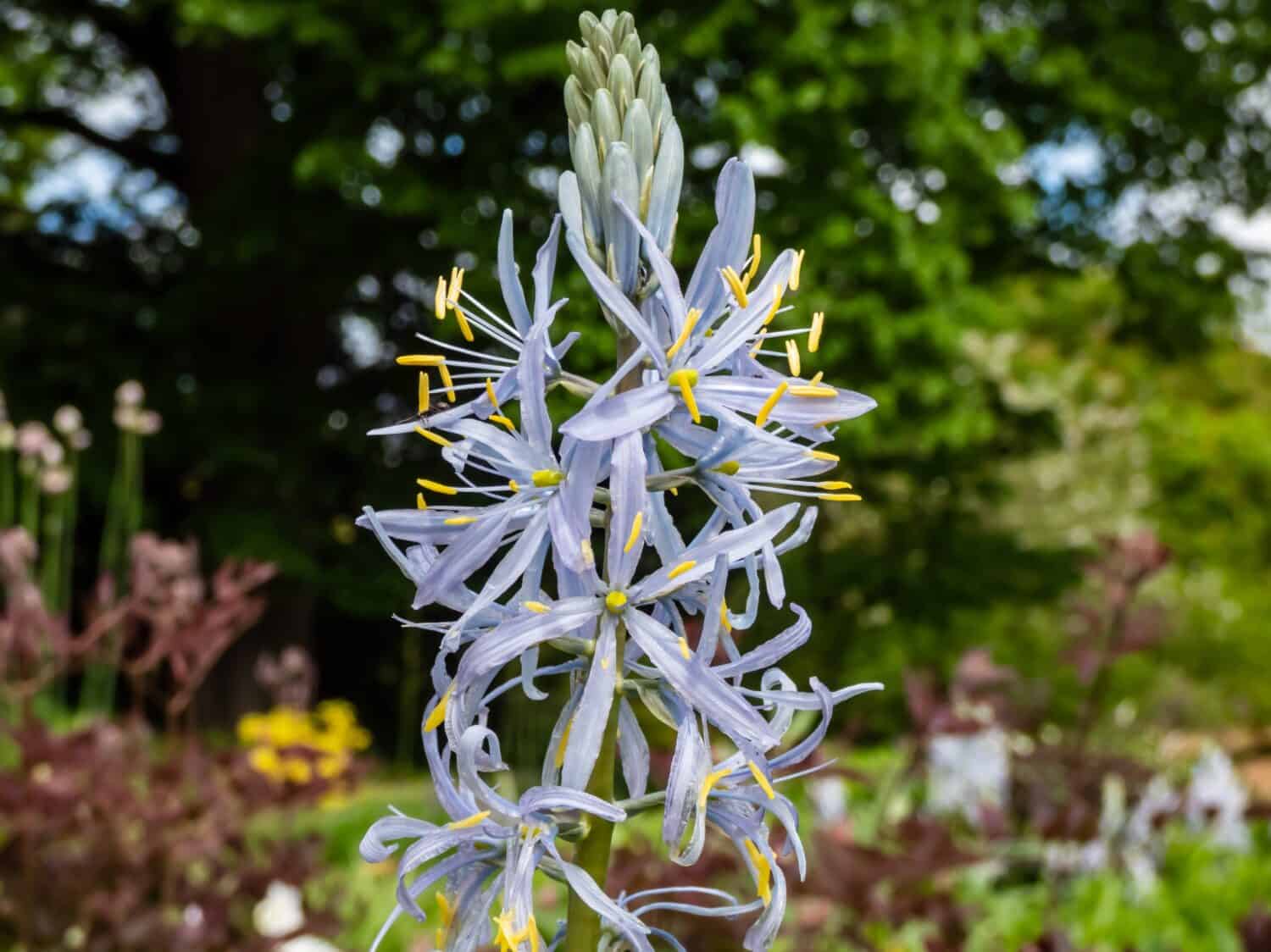
A unique perennial, Cusick’s camas blooms from late spring to early summer.
©Kristine Rad/Shutterstock.com
Cusick’s camas is a unique perennial known for its slender spikes adorned with anywhere from 30 to 100 delicate, pale blue, starry blossoms. Each of these blooms flaunts six prominent tepals, a contrasting green center, and yellow stamens. These are arranged in a sequential pattern from the base to the tip on sturdy, slender stems.
Cusick’s camas flowers make their grand appearance from late spring to early summer, sprouting from a base of elongated, undulating, mid-green leaves. In the garden, this bulb stands out, offering a fresh aesthetic during a period when many summer plants are just getting started. It pairs wonderfully with other late-spring flowers and looks especially captivating when placed alongside pink or white delphiniums or irises.
For optimal growth, Cusick’s camas prefers a sunny to partially shaded spot in nutrient-rich, moist, and well-draining soil. It’s best to plant these bulbs about 4 to 6 inches deep and spaced 6 inches apart in the fall.
10. Blue Bead Lily (Clintonia borealis)
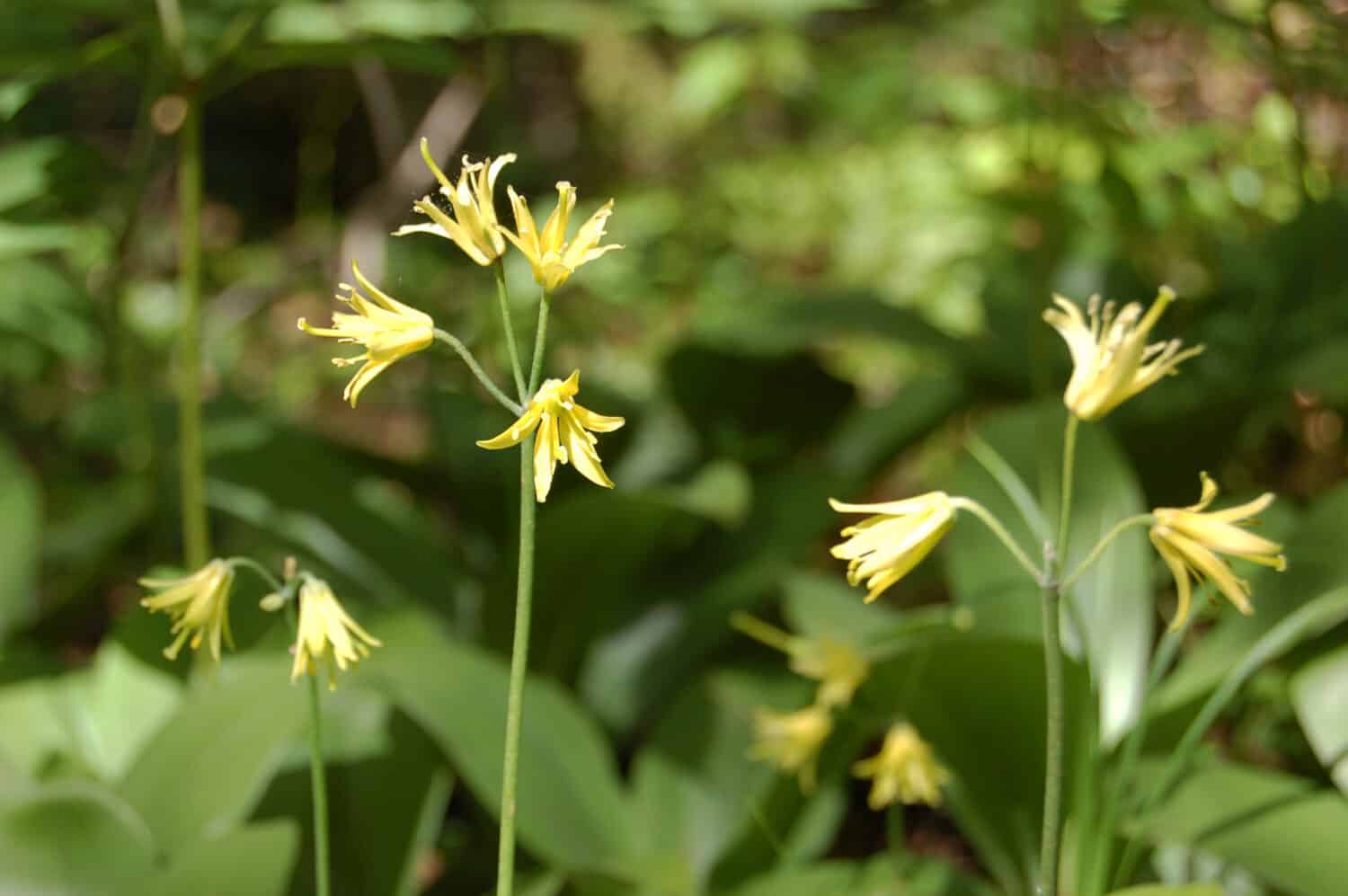
Boasting pale yellow flowers that bloom in the summer, the blue bead lily is a great pick for any South Dakota garden.
©L.A. Faille/Shutterstock.com
Blue bead lily is a woodland-based perennial with a foundation of 3 to 5 broad, shiny green leaves, each reaching lengths up to 12 inches. As late spring transitions to early summer, a stem without leaves shoots up from the main cluster, crowned with 3 to 6 drooping, pale yellow blooms.
During late summer, these flowers give way to striking, glossy blue, dark berries. While they’re not fit for human consumption and are slightly toxic, creatures like chipmunks and birds enjoy them. When planted in groups beneath leafy trees in cool, damp, shaded spots, this lily can naturally spread, creating a picturesque carpet of green.
For best growth, blue bead lily should be planted in nutrient-rich, moist soil with a sandy or loamy texture in areas receiving partial to full shade. It’s ideal to get them in the ground during spring’s milder temperatures after frost risks have passed but before the intense warmth of summer sets in.
11. Threadleaf Coreopsis (Coreopsis verticillata)

The sunny blooms of the threadleaf coreopsis brighten up any outdoor space.
©DavidMicD/Shutterstock.com
Since its introduction in the gardens of the 19th century, threadleaf coreopsis has remained a favorite due to its abundance of bright golden-yellow blooms that grace gardens from mid-summer to early fall. Consistent deadheading can prolong this vibrant display. A magnet for nature’s helpers, it’s often buzzing with bees, butterflies, and other beneficial insects.
This perennial sets itself apart with its slender stems that hold the flowers high, contrasting with its fine, needle-like dark green leaves. Given South Dakota’s warm and sometimes humid summer climate, this heat, humidity, and drought-resilient plant proves invaluable.
For optimal growth, this plant prefers sunny spots with soil that’s on the drier side and slightly acidic. To propagate, you can divide the plant during the cool of fall or the freshness of early spring. Those looking to grow from seeds can plant them outside either in the late fall or as spring emerges, with no cold treatment necessary.
12. Maiden Pink (Dianthus deltoides)

Maiden pink flowers are award-winning perennial flowers, perfect for sun-drenched South Dakota gardens.
©iStock.com/ANGHI
This flower is a winner of the esteemed Garden Merit Award from the Royal Horticultural Society. Maiden pink is a robust evergreen perennial that quickly grows into a carpet of slender green leaves. As summer approaches, this green canvas gets adorned with a multitude of fringed blossoms that come in colors ranging from rich reds to soft pinks and pure whites.
Set on branching stems, these delicate flowers are a favorite for bees and butterflies. Yet, despite their charm, thankfully, deer tend to steer clear of them. Whether you’re looking to add texture to a rock garden, border a pathway, or fill gaps between paving stones, maiden pink is a versatile choice.
This flower thrives under full sun and prefers soil that’s neutral to slightly alkaline and drains well. If you’re starting with seedlings, the best time to introduce them to your garden is during the warmer days of late spring, once the soil has warmed up and there’s no more risk of prolonged heavy rains or frost.
For those in South Dakota, this heat-loving perennial flower is a delightful addition to sun-drenched gardens.
Summary of Best Perennial Flowers for South Dakota
| Number | Flower | Blooming Period |
|---|---|---|
| 1 | Common Yarrow | Early to late summer |
| 2 | Russian Hollyhock | Late spring to late summer |
| 3 | Lady’s Mantle | Late spring to early summer |
| 4 | Blue Star | Late spring to early summer |
| 5 | Snowdrop Anemone | Mid-spring to early summer |
| 6 | Rocky Mountain Columbine | Late spring to early summer |
| 7 | Sea Thrift | Mid-spring to summer |
| 8 | Heartleaf Bergenia | Early spring to early summer |
| 9 | Cusick’s Camas | Late spring to early summer |
| 10 | Blue Bead Lily | Late spring to early summer |
| 11 | Threadleaf Coreopsis | Mid-summer to early fall |
| 12 | Maiden Pink | Late spring to late summer |
Thank you for reading! Have some feedback for us? Contact the AZ Animals editorial team.







